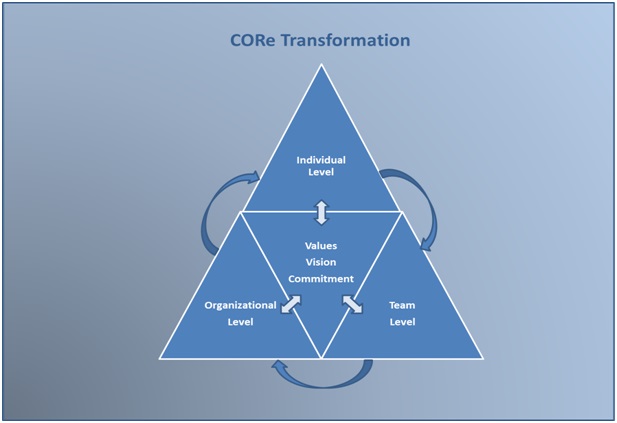A Coaching Model Created by Matthew Heim
(Transformation Coach, UNITED STATES)
The Need
Seeking alignment between an organization’s strategic goals and the individuals involved in carrying them out will often fail if such alignment efforts are limited to traditional planning and project management methods. Plans tend to erode and even fail when execution is challenged by the deeper beliefs and values of those individuals involved. In order to attain and sustain a high level of motivation around an organization or a team goal, the individuals charged with carrying out the goal must feel that it is in alignment with their own beliefs and values. When this is not the case, individuals can begin to feel out of sync with the rest of the organization, resulting in dissatisfaction, lack of motivation, and eventually even burnout.
The Opportunity
If we can help individuals find a more personal sense of meaning in their organization’s or team’s goals, dissatisfaction and burnout can often be avoided, and lassitude can be transformed into a higher state of aspiration. People have always sought meaning in their lives, and meaning can be revealed when an individual’s personal values and vision are at the forefront of what they do, and when they can see the alignment between their personal values and vision and the goal of the organization. The CORe Coaching Model (Commitment Oriented Realignment) is designed to help reveal a person’s core values and to create a vision for themselves, where they can see the deeper meaning in the goals that they are about to realize.
In Practice
The CORe model is designed to work with the individual via coaching (inside-out approach), to help create a sense of inspired action. However, an organization that wants to get out ahead of burnout and lack of motivation among its individual contributors can use the CORe model at the leadership and team levels (outside-in approach), followed by individual coaching of the individuals involved. These two approaches are defined in detail below.
CORe – Inside-Out Approach:
The CORe inside-out approach starts with the individual, identifying signs of work struggles, lack of motivation, and burnout. Other than working proportionally too many hours, these symptoms are typically signs that the coaching client either fails to find meaning in their work or that their work is not aligned with their core values – those which make them feel whole and complete. The challenge for most people is that they are not aware of their own core values, and are left working in an environment devoid of personal control, choice, and empowerment.
The “Peak Experiences” exercise, which is part of David Cooperrider’s Appreciative Inquiry approach[1] can help the client to identify peak experiences in their lives, and select a value or emotion that is best associated with that experience. Once these core values are revealed to the client, s/he can use those values as a lens or litmus test, against which future decisions and choices are measured. The client can then choose to either ignore actions that are not in alignment with their values or seek ways in which they can connect the action at hand with their values. With explorative coaching, the latter is often achievable, and certainly more sustainable, in terms of motivation and inspiration.
Another tool that can be used to find deeper meaning in one’s work is a visioning and visualization exercise.[2]This the process can be used for general life coaching (i.e., the Wheel of Life) or focused on a specific action or project in which the client is involved. This process is facilitated, or guided by the coach, where the coach brings the client into a meditative state, and then allows the client to explore a possible future (visioning). When the vision or new setting is established, the coach can then use visualization techniques to allow the client to explore various avenues of their vision, encouraging the client to use sensory perception (e.g. sight, hearing, smell, taste, etc.) to deepen the visionary experience, thus establishing cellular memory, which cannot be distinguished from a “real” experience vs. an experience through vision.
The coach can then encourage the client, throughout the visioning process, to feel and take note of the positive emotions evoked through the visioning and visualization exercise, ensuring that any action taken towards the vision is inspired, and will bring a deeper sense of meaning to the client. After the visioning process, the coach can walk the client through a commitment process, encouraging them to transform these newly inspired visions into inspired action.
The “Outside-In” Approach
The Outside-In approach of the CORe model is similar to the Inside-Out approach, except that it is performed in a group setting with the objective of establishing a collective group (i.e., team or leadership) vision. In this approach, the coach walks the group through a guided visioning and visualization exercise focused more on a team or organizational objectives. While each individual participant is allowed to explore their own vision of the scenarios provided by the coach, the participants are then asked to share their experiences with their peers, and a collective vision is thus formed.
This approach has several benefits, including the following:
- It enables the creation of a shared vision across a multi-disciplinary group
- It allows the group to self-select the best actions to be taken in a prioritized manner
- It allows each participant to experience their own personalized part of the vision
- Because of the visual simulation, it creates a higher sense of buy-in and belief of achievability from each participant (as if they had already carried out the task)
- Inspired action, when combined with heartfelt commitment, can inspire and help the client achieve new goals while avoiding the pitfalls of extended lassitude.
[1] Cooperrider, David, “Appreciative Inquiry: A Positive Revolution in Change,” Berrett-Kohler, 2005
[2] Heim, Matthew, “Breaking the Musashi Code: Transcending Competition Through Visionary Strategy,” Visionary Partnership Press, 2007
